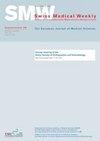Hospitalists’ perception of their communication with primary care providers – survey results from six hospitals in Central Switzerland
IF 2.1
4区 医学
Q2 MEDICINE, GENERAL & INTERNAL
引用次数: 0
Abstract
OBJECTIVES: Due to the increasing complexity of the healthcare system, effective communication and data exchange between hospitalists (in-hospital physicians) and primary care physicians (PCPs) is both central and challenging. In Switzerland, little is known about hospitalists’ perception of their communication with PCPs. The primary objective was to assess hospitalists’ satisfaction with their communication with PCPs. Secondary objectives addressed all information about the referral process and communication with PCPs during and after the hospital encounter. Lastly, the results of a previous survey among PCPs were juxtaposed to compare their responses to similar questions. METHODS: This study surveyed hospitalists in six hospitals in the Central Switzerland region. The survey was sent via email to hospitalists from November 2021 to February 2022. The questionnaire contained 17 questions with single- and multiple-choice answers and the option of free-text entry. Exploratory multivariable logistic regression was used to analyse independent associations. RESULTS: In total, 276 of 1134 hospitalists responded (response rate 24.3%): (1) the majority of hospitalists are satisfied with the general communication (n = 162, 58.7%) as well as with referral letters (n = 145, 52.5%), (2) preferred information channels for referral letters are email (n = 212, 76.8%) and electronic portals (n = 181, 65.5%), (3) the three most important items of information in referrals are: medication list, diagnoses and reason for referral. In multivariable regression, compared to other clinicians, internists independently favoured informing PCPs of emergency admissions of their patients in a timely manner (OR 2.04; 95%CI 1.21–3.49). Comparing responses from PCPs (n = 109), the most prominent discrepancy was that 67% (n = 184) of hospitalists claimed to “always” inform after an encounter, whereas only 7% (n = 8) of PCPs agreed. CONCLUSION: Most hospitalists are satisfied with the communication with PCPs and prefer electronic communication channels. Room for improvement was found around timely transmission of patient information before and after hospital encounters.医院医生对与初级保健提供者沟通的看法--瑞士中部六家医院的调查结果
目的:由于医疗保健系统日益复杂,医院医生(院内医生)与初级保健医生(PCP)之间的有效沟通和数据交换既重要又具有挑战性。在瑞士,人们对住院医生与初级保健医生之间的沟通知之甚少。研究的首要目标是评估住院医生对与初级保健医生沟通的满意度。次要目标是了解转诊流程的所有信息以及在医院就诊期间和之后与初级保健医生沟通的情况。最后,我们将之前对初级保健医生的调查结果并列出来,以比较他们对类似问题的回答。调查于 2021 年 11 月至 2022 年 2 月期间通过电子邮件发送给住院医生。问卷包含 17 个问题,有单选题和多选题,还可输入自由文本。结果:1134 名住院医师中共有 276 人回复(回复率为 24.3%):(1)大多数住院医师对一般沟通表示满意(n = 162,58.7%)以及转诊信(145 人,52.5%);(2)转诊信的首选信息渠道是电子邮件(212 人,76.8%)和电子门户网站(181 人,65.5%);(3)转诊中最重要的三项信息是:用药清单、诊断和转诊原因。在多变量回归中,与其他临床医生相比,内科医生更倾向于及时向初级保健医生告知患者的急诊入院情况(OR 2.04;95%CI 1.21-3.49)。比较初级保健医生的回答(n = 109),最突出的差异是 67% 的住院医师(n = 184)声称 "总是 "在会诊后告知,而只有 7% 的初级保健医生(n = 8)同意。结论:大多数医院医生对与初级保健医生的沟通表示满意,并更喜欢电子沟通渠道。
本文章由计算机程序翻译,如有差异,请以英文原文为准。
求助全文
约1分钟内获得全文
求助全文
来源期刊

Swiss medical weekly
医学-医学:内科
CiteScore
5.00
自引率
0.00%
发文量
0
审稿时长
3-8 weeks
期刊介绍:
The Swiss Medical Weekly accepts for consideration original and review articles from all fields of medicine. The quality of SMW publications is guaranteed by a consistent policy of rigorous single-blind peer review. All editorial decisions are made by research-active academics.
 求助内容:
求助内容: 应助结果提醒方式:
应助结果提醒方式:


